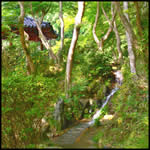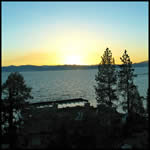Gary's Parries 04/06/06
 This week’s Gary’s Parries topics are:
This week’s Gary’s Parries topics are:
1. No Need To Go Below ISO 200
2. Whether To Weatherproof Or Waterproof
3. Nikon D70 Front Focusing Problem: S-O-L-V-E-D
Introducing this week’s Gary’s Parries column. Everything you always wanted to know about digital cameras, but were afraid to ask. No question too difficult, or too easy. As a Senior Principal Software Engineer, and a former Assistant Professor of Computer Information Systems, as well as a recording studio owner/operator, and now, a digital camera enthusiast, GARY has more digital camera knowledge in his entire brain than most people have in their little finger. In the unlikely event that GARY would not know the answer to your question, he will answer it anyway, true to the spirit of the word “Parries”, a fencing term which, in this context, implies “cleverly evasive answers”. So let your imagination run wild. Email all your nagging digital camera questions to: [email protected], and then, En Garde!
You may also attach to your email an ORIGINAL PHOTO of your choosing. A preview of the photo will be displayed with your question, and a full-sized version will be just a click away. No personal information will be published with your question unless you specifically include it in the text or attached photo of your email, which may be further edited for grammar, content, or other reasons.
***
*** QUESTION 1—- NO NEED TO GO BELOW ISO 200
***
I’ve owned several 35 MM SLRs but have yet to purchase my first digital one. One thing I find strange is that several dSLRs, notably the Nikons, lack an ISO setting below 200. I liked shooting lower-speed film (esp. ISO 100) and routinely use the ISO 50 setting on my compact digital cameras because I like the saturation.
Why am I concerned with ISO speeds when nobody else seems to be?
Thanks,
Ben
***
*** ANSWER 1
***
Ben, this is an excellent question, especially considering you have yet to own a dSLR. But rest assured, you are not the only one concerned about ISOs. In fact, it is because camera manufacturers are so concerned that they would even consider limiting their minimum ISO to 200. Allow me to explain.
First, a little background information, so that we are all on the same page.
When do you use low-speed film? Obviously, it is when you are shooting in bright light situations. But wouldn’t it be easier to always keep your camera loaded with high-speed film, which will work fine in bright light situations, and will allow you to shoot in low light situations, as well? In fact, many people have done just that, and if all you want are snapshot-sized prints, you can obtain perfectly acceptable results.
But suppose you want 8” x 10” enlargements, or larger. If you examine an enlargement of an image shot with high-speed film, and compare it with the exact same image shot with low-speed film, you will notice some significant differences.
For one, you will notice larger grain in high-speed film enlargements. This is due to the fact that high-speed film emulsion uses larger particles of silver to achieve its higher sensitivity to light. Because of this, high-speed film enlargements will have a grainier texture compared to low-speed film enlargements, and will therefore show less image detail.
Low-speed film enlargements will also exhibit better contrast and color saturation, benefits of the additional light utilization, as required due to the film’s lower sensitivity to light. And because low-speed films contain less silver in their emulsions, they are also less expensive than high-speed films. So, with regard to film, there are definitely advantages to using low-speed films whenever practical.
With digital cameras, however, the ISO setting is nothing more than an amplification level. Unlike film, which uses emulsions with differing characteristics to vary its ISOs, a digital camera’s ISO settings do not change the characteristics of its image sensor. The fact that your digital compacts exhibit better saturation at ISOs below 200 is a result of their specific internal image processing (or lack thereof).
If you look at ISO crops from any digital camera review, you will notice that, as the ISO level increases, so does the image noise, and significantly so. Why then would any camera manufacturer limit a camera’s minimum ISO to 200, rather than the usual range of 50 to 100? It is because that camera is already noise free at ISO 200, so there would be NO ADVANTAGE to having ISO values below 200.
Think of it this way, Ben. If there were an ISO 200 film available that offered the exact same detail, contrast, and color as ISO 100 film, and at the exact same price, would you ever need to use ISO 100 film?
Actually, I can think of two situations where you might: (1) if you were in a spacecraft orbiting the sun and wanted to shoot a close-up of a solar flare, but the image was overexposed even with your lens closed down all the way and your camera at maximum shutter speed; and (2) if you were shooting a brightly lit moving target and wanted to achieve both minimum depth of field and maximum image blur of the subject at the same time. For such situations, you may want to obtain a Canon 5D and utilize its ISO 50 option. :)
***
*** QUESTION 2—- WHETHER TO WEATHERPROOF OR WATERPROOF
***
I am looking for a weatherproof digital camera to use on my vacations in various climates, ranging from cross-country skiing to tropical rainforest backpacking. The camera has to be small and light, and able to withstand low temperatures, high humidity, and occasional water dousing. I am not sure which camera to get, and whether I should get one that is also waterproof, in case I want to take it snorkeling or scuba diving.
Please help.
***
*** ANSWER 2
***
There are four weatherproof cameras I would recommend for your intended use, two of which are also waterproof.
1. Olympus Stylus 710
2. Olympus Stylus 810
3. Olympus Stylus 720 SW
4. Pentax Optio W10
The 710 is the smallest and lightest of the bunch; however, the others are not that much bigger or heavier, so unless size and weight are critical, there may be some advantage to the others over the 710.
The 710 has received unfavorable reviews for its poor image quality. The 810 uses a larger CCD (1/1.8” vs. 1/2.3” for the 710), but crams an additional megapixel into it (8 megapixels vs. 7 megapixels for the 710), so its image quality is not much better. The 810 does have a much higher resolution LCD (230K pixels vs. 115K pixels for the 710), as well as a faster lens.
The 720 SW is almost identically spec’d to the 710, except that it is waterproof (vs. just weatherproof for the 710), so it has all the same negatives as the 710, plus a few of its own. The lens placement of the 720 SW is exactly where you would place your left hand on the camera, which makes it quite easy for your fingers to inadvertently become part of the shot. Even worse, the 720 SW has a non-extending lens with a sliding lens cover that becomes a trap for both dirt and water, making it difficult to keep the lens clean and free of moisture. It also makes it susceptible to scratching due to trapped sand particles being dragged across the lens when the sliding cover opens and closes.
I would not recommend the 720 SW over the 710 or 810 unless you absolutely need a waterproof camera. However, if you are not an avid underwater user, but would like to have the option of occasionally using the camera underwater, I would recommend one of the 710’s optional underwater housings. The 810 does not (yet) offer such an option.
The Pentax Optio W10 is also rated for underwater use, but only to 1.5m (vs. 3m for the 720 SW). This still might be a better choice than the Olympus cameras, mainly for its better image quality; however, it uses the same LCD as the 710 and 720 SW, so it is inferior to the 810 in that regard. Like the 720 SW, the W10 has a non-extending lens, but it is not placed near your fingers, and it does not have a sliding lens cap, so it avoids the problems of the 720 SW’s non-extending lens. Its lens is also faster than that of the 710 and 720 SW.
Hope this information helps you with your camera selection.
P.S. If you plan on dropping your camera a lot, the 720 SW’s waterproof and shockproof combination might prove to be useful, especially if you plan on dropping your camera into water. :)
***
*** TOPIC 3—- NIKON D70 FRONT FOCUSING PROBLEM: S-O-L-V-E-D
***
 Rupert, I think we finally got to the bottom of your D70 front focusing problem, and I appreciate your patience in this matter.
Rupert, I think we finally got to the bottom of your D70 front focusing problem, and I appreciate your patience in this matter.
After extensive testing, it was found that, when using the D70’s AE-L/AF-L button in the AF Lock Only mode (Custom Setting 15), you need to keep the button pressed in order to maintain a focus lock. If you release the button prior to taking the shot (as you were doing), the D70 will refocus when you press the shutter-release, so your prefocusing will have been all for naught. The fact that your shots were not properly focused when using the AE-L/AF-L button is undoubtedly due to the fact that the camera was refocusing in an unintended manner.
Alternatively, you can use the AE-L/AF-L button in its AF-ON mode (Custom Setting 15). In this mode, the camera will focus when you press the button, and remain focused when you release the button; however, if after releasing the button, you then recompose the shot and press the shutter-release, the shot will not be taken unless the subject, as determined by your focus area selection, is still in focus.
If you use the D70 in Auto mode or any of its scene modes (which you said you were not doing), you must also change Custom Setting 3 from its default Closest Subject focusing mode; otherwise, the D70 will always front focus. As a precaution, I would change Custom Setting 3, even when using the Aperture or Shutter Priority modes, just to ensure that the D70 does not, for some undocumented reason, revert to its Closest Subject focusing default.
Rupert, one thing you should keep in mind. No camera’s auto-focus is 100% foolproof. There will always be situations that the AF cannot handle, no matter how high-end the camera is. That is why high-end cameras also offer manual focus. I know you don’t like using manual focus, but if you upgrade to a higher-end camera just to avoid its use, I think you will be disappointed.
[Note: Thanks to Nick in Japan for submitting the accompanying photo, and much gratitude to Rob Huberman from ComteQcom.com for his exhaustive D70 testing. - Ed.]
***
[Column photo “The Photographer” by Brenda LaFleur of Brenda LaFleur Photography.]


